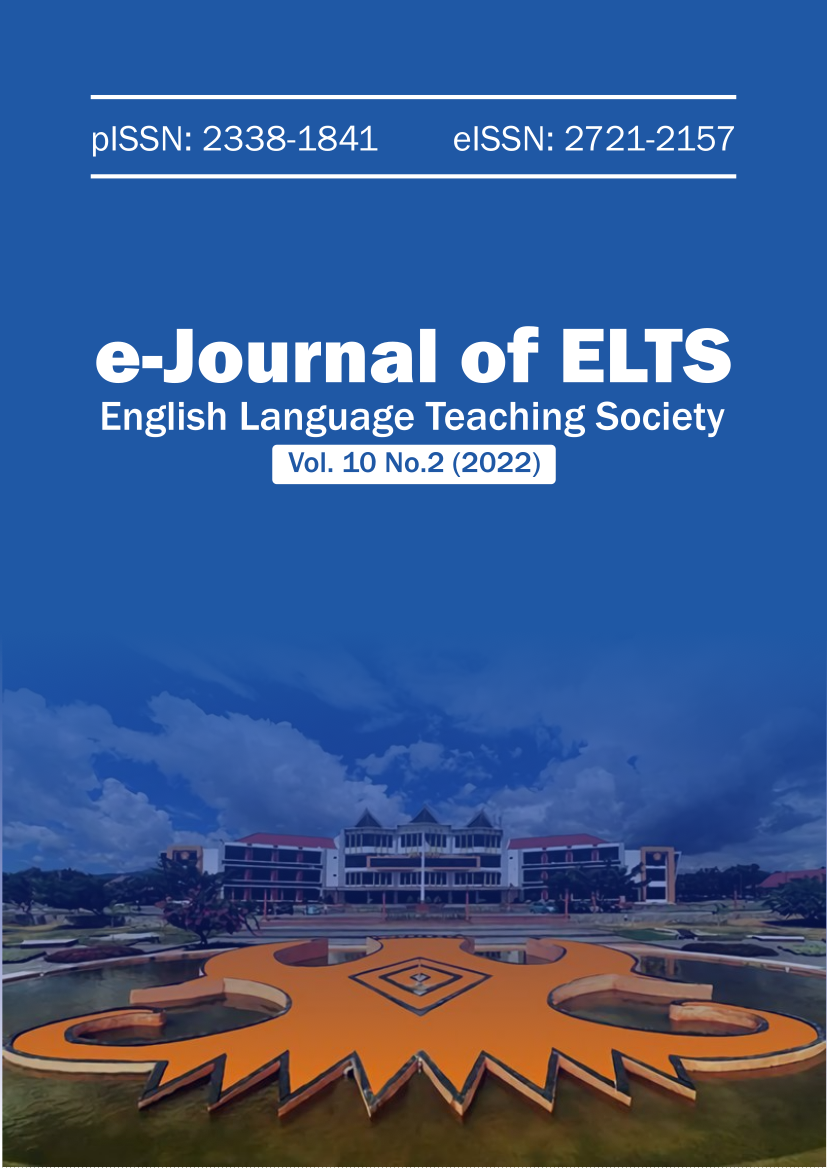TEACHERS’ STRATEGIES IN TEACHING ENGLISH DURING PANDEMIC COVID-19
DOI:
https://doi.org/10.22487/elts.v10i2.2498Keywords:
teachers, strategies, teachingAbstract
At the end of 2019, the world was shocked by the Covid-19 virus in Wuhan, China. This situation requires teaching and learning activities to be carried out at home. This research aims to find out the teachers’ strategies in teaching English during Pandemic Covid-19 at SMP Islam Terpadu Qurrata 'Ayun Palu. This research used qualitative descriptive method. Data collection was carried out with questionnaire and recorded interview procedure. The subjects of the research were two English teachers. Based on the results of the research, the researcher can draw the conclusion that the strategies used by teachers are first is communicative language teaching and many types of applications, second is class management. The strategies used by teachers were quite effective and increased students' interest in learning, so that students are motivated to learn English during the pandemic.
References
Arikunto & Suharsimi.(2000). Manajemen Penelitian. Jakarta: PT. Rineka Cipta.
Budio, S.(2019). Strategi manajemen sekolah. Jurnal Menata.2(1): 56-72
Cresswell & John W.(2014). Research design pendekatan kualitatif, kuantitatif, dan mixed. Yogyakarta : Pustaka Pelajar
Danim, S & Darwis.(2003). Metode Pnelitian Kebidanan: Prosedur Kebidanan dan Etik.Jakarta: Penerbit Buku kedokteran EGC
Handayani, S.(2015). Pentingnya Kemampuan Bahasa Inggris Sebagai Dalam Mnyongsong Asean. Ikatan Sarjana Pendidikan Indonesia (ISPI): Journal Profesi pendidikan. 3(1): 102-106
Haidir, & Salim. (2012). Strategi Pembelajaran . Medan: Perdana Publishing.
Ilyosovna, A.N (2020) The Important Of English Language.International Journal on Orange Technologies: Research parks. 2(1): 22-24
Miles, M.B, & Huberman, A.A.(1992). Analisis Data kualitatif .Jakarta: Penerbit Universitas Indonesia
Nickols, F.(2016). Strategy Definitions & Meanings. Open journal of business and management. 6(2): 1- 14
Rajagolapan, I.(2019).Concept of Teaching. Shanlax international journal of Education. 7(2): 2-8.
Rijali, A.(2018) Analisis Data Kualitatif. Journal Alhadharah.7(33) : 81-95
Richard & Schmidt, R.(2002). Technology in language teaching today. Indonesian journal of English language teaching. 10(1):18-31
Rusandi, M (2021). An analyis of teachers’ strategies in teaching speaking English on online learning.Tesis.Islamic University Sulthan Thaha Saifuddin
Sholikhin, M.I, Nurdianingsih, F. & Matin, M.F .(2021). An analysis of teacher’s strategies on English learning during pandemic. Journal pendidikan Edutama. 8(2): 1-5
Sopian, A.(2016). Raudhah proud be professionals. Jurnal tarbiyah islamiyah peran guru . 1(1): 88-97
Sugiyono.(2008). Metode Penelitian Kuantitatif Kualitatif dan R&D. Bandung: Penerbit Alfabeta.
Walidin W.,Idris S.& Za, T.(2015). Metodologi Penelitian Kualitatif & Grounded Theory. Banda aceh: FTK Ar-Rainiry Press
Yusuf, A.M (2014). Metode penelitian kuantitatif, kualitatif dan penelitian gabungan. Jakarta: Prenadamedia group
Downloads
Published
How to Cite
Issue
Section
License
Copyright (c) 2022 Jumrah AM Parusi, Mawardin M. Said, Mashuri Mashuri

This work is licensed under a Creative Commons Attribution-ShareAlike 4.0 International License.
Authors who publish with e-Journal English Language Teaching Society (ELTS) agree to the following terms:
- Authors retain copyright and grant the journal right of first publication with the work simultaneously licensed under a Creative Commons Attribution License (CC BY-SA 4.0) that allows others to share the work with an acknowledgment of the work's authorship and initial publication in this journal.
- Authors are able to enter into separate, additional contractual arrangements for the non-exclusive distribution of the journal's published version of the work (e.g., post it to an institutional repository or publish it in a book), with an acknowledgment of its initial publication in this journal.
- Authors are permitted and encouraged to post their work online (e.g., in institutional repositories or on their website) prior to and during the submission process, as it can lead to productive exchanges, as well as earlier and greater citation of published work.








